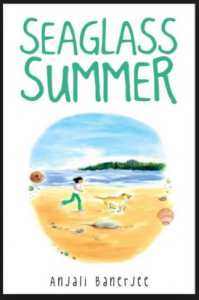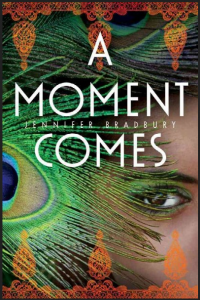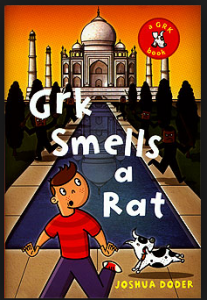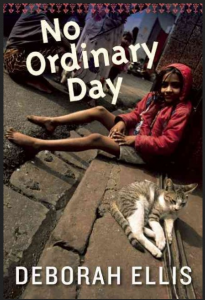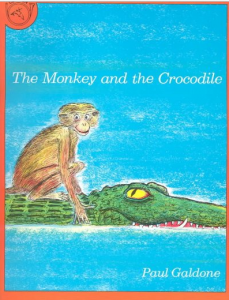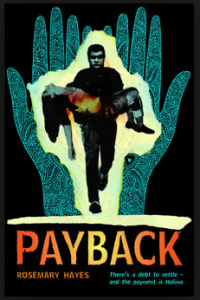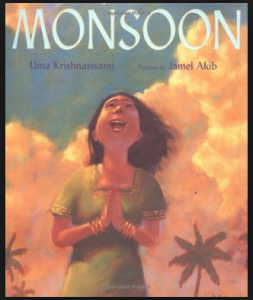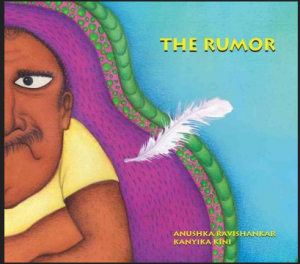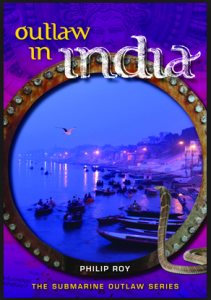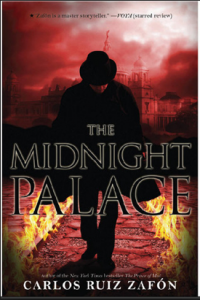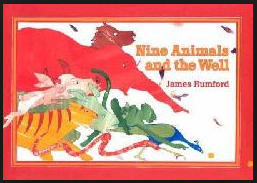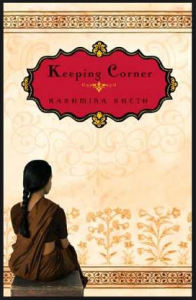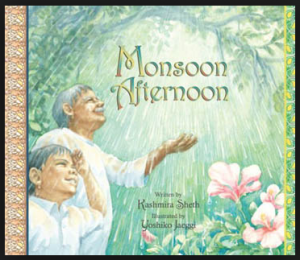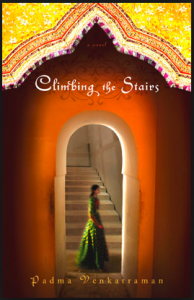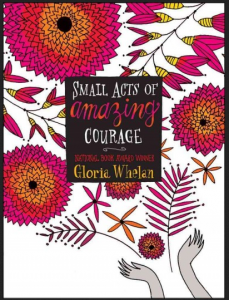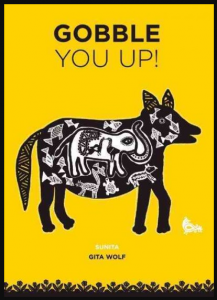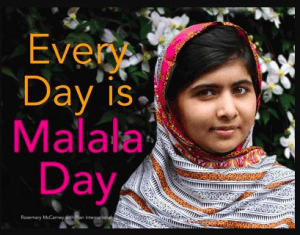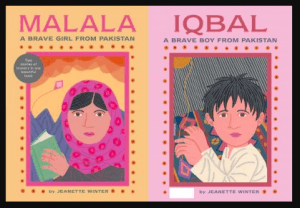Looking for a story about India, Pakistan or Bangladesh?
(* = my favourites)
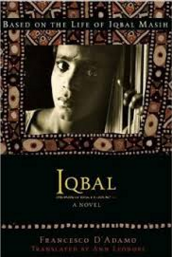
D’Adamo, Francesco. Iqbal: a Novel. New York: Atheneum Books for Young Readers, 2003.
“A fictionalized account of the Pakistani child who escaped from bondage in a carpet factory and went on to help liberate other children like him before being gunned down at the age of thirteen.” – CIP. [Child abuse; Child labor; Pakistan; Rug and carpet industry]
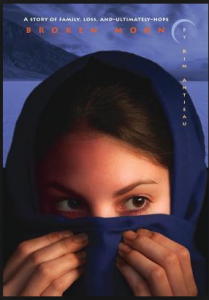
* Antieau, Kim. Broken Moon. Margaret K. McElderry Books, 2007.
Eighteen-year-old Nadira, scarred and considered ‘soiled goods’, disguises herself as a boy in order to rescue her younger brother who has been kidnapped from Pakistan and forced to become a camel racer. (Pakistan; Kidnapping; Brothers and sisters; Camel racing; Scheherazade (Legendary character); Courage)
Banerjee, Anjali. Looking for Bapu. Yearling, 2006.
After his grandfather dies, eight-year-old Anu struggles to contact his spirit. Set in Washington State after the bombing of the New York City Twin Towers, this story is beautifully written and full of realistic details about life for immigrants from India. Unfortunately, the main character sometimes seems more like an eleven-year-old than an eight-year-old but apart from some rather far-fetched observations, the story is a delight to read and should appeal to readers in grades five to seven. It could be compared to Missing May by Cynthia Rylant. (Death; Grief; Humour; Friendship; Schools; Family life; India; Hinduism)
Banerjee, Anjali. Seaglass Summer. Wendy Lamb Books, 2010.
While spending the summer with her uncle in the Pacific Northwest instead of visiting relatives in India, eleven-year-old Poppy Ray discovers the life of a veterinarian isn’t as glamourous as she’d expected. Readers of Becca at Sea by Deirdre Baker might comparing these two cheerful novels about independent and adventurous heroines. (Islands, Veterinarians, Uncles, Summer; Friendship)
** Bradbury, Jennifer. A Moment Comes. New York: Atheneum Books for Young Readers, 2013.
“As the partition of India nears in 1947 bringing violence even to Jalandhar, Tariq, a Muslim, finds himself caught between his forbidden interest in Anupreet, a Sikh girl, and Margaret, a British girl whose affection for him might help with his dream of studying at Oxford.” – CIP. (Historical fiction; India; Muslims; Sikhs; Violence)
* Budhos, Marina. Ask Me No Questions. Atheneum Books for Young Readers, 2006.
Fourteen-year-old Nadira and her family move from Bangladesh to New York City. But their visas expire, the Twin Towers are bombed on September 11 and they all start to hide their identities. Will they ever be safe again? On ERAC recommended novel list for grade eight. (Bangladesh; Immigrants; Schools; New York City; September 11; Secrets; Muslims; Fear; Prejudices; Self-reliance; Teenagers; Culture conflict)
* D’Adamo, Francesco. Iqbal. Aladdin Paperbacks, 2005, c2001.
Iqbal, a child labourer who escapes from a Pakistani carpet factory, returns to help other children escape before being gunned down while still only thirteen years old. Based on a true story, this short novel is on the ERAC recommended novel list for grades 8 to 9. (Pakistan; Child labor; Child abuse; Runaways; Masih, Iqbal; Courage; Murder; AR 5.1)
* Doder, Joshua. Grk Smells a Rat! Anderson Press, 2008.
Tim and his dog Grk are off to watch Max play in a tennis tournament in Delhi, India. But when they discover enslaved children working in hidden factories, they have to help even if it places their lives in danger. Action, suspense and humour combine to make this a great read for fourth to seventh graders. Part of a fast-paced series the adventures of Grk and Tim. (India; Adventure and adventurers; Dogs; Humour; Mystery and detective stories; Child labor; Tennis)
…
Ellis, Deborah. No Ordinary Day. Toronto, ON: Groundwood Books / House of Anansi Press, 2011.
“Valli has always feared the lepers living on the other side of the train tracks in the coal town of Jharia, India, so when a chance encounter with a doctor reveals she also has leprosy, Valli rejects help and begins an uncertain life on the streets.” – CIP [Courage; Hansen’s Disease; Homelessness; Orphans; Poverty; Runaways]
Ellis, Deborah. Mud City. Groundwood Books, 2003.
The third in a trilogy about an Afghan girl, Parvana escapes the rule of the Taliban in her own country only to find herself in a refugee camp in Pakistan. On ERAC recommended novel list for grades 6 and 7. (Afghanstan; Pakistan; Refugee camps; Sex role; War; Perseverance; AR 4.6)
* Galdone, Paul. The Monkey and the Crocodile: a Jakata Tale from India. New York: Clarion Books, 1997.
“A retelling of one of the Indian fables relating to the former births of Buddha in which as a monkey he manages to outwit the crocodile who decides to capture him.” – CIP. A humorous picture book by an expert at retelling and illustrating folktales. Highly recommended for children 6-years-old and up.
Hayes, Rosemary. Payback. Frances Lincoln Children’s Books, 2009.
Halima’s father saved the family’s property in Pakistan when she was eight years old by promising her in marriage to a relative. Now living in London, England and attending university, she discovers her father’s plan to keep his promise and uphold his honour even if it means forcibly sending her to Saudi Arabia where her husband-to-be is a migrant worker. How can she escape? This quickly-paced and informative novel is based on a true story and will appeal to readers in grades seven to ten. (Pakistan; England; Family life; Muslims; Courage; Kidnapping; Friendship; Culture conflict; Sex role)
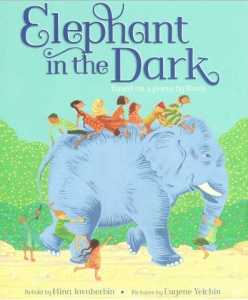
Javaherbin, Mina. Elephant in the Dark. New York : Scholastic Press, 2015.
This cheerful picture book – written in the style of a folktale, based on a poem by Rumi, and illustrated by Eugene Yelchin – offers a reminder that we do not always see the whole picture in life. This story is recommended as a read-aloud for children up to eight years of age but could also be used to start a discussion with older students.
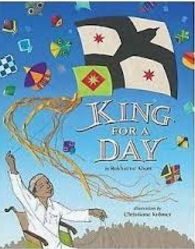
Khan, Rukhsana. King for a Day. New York: Lee & Low Books Inc., 2013.
“Even though he is confined to a wheelchair, a Pakistani boy tries to capture the most kites during Basant, the annual spring kite festival, and become “king” for the day. Includes an afterword about the Basant festival.” – WAFMS. A picture book for readers 7-years-old and up. [Kites; Pakistan; People with disabilities; Wheelchairs]
Khan, Rukhsana. A New Life. Groundwood Books, 2008.
Eight-year-old Khadija, her older brother and her parents arrive in Canada from Pakistan. The weather is cold and wet, their new home is a small apartment, and everything is unfamiliar. They feel like poor, unwanted outsiders. Gradually, though, they learn English, adjust to their new home and become Canadian citizens. This short novel would be best appreciated by students in grades three to six. (Immigrants; Pakistan; Canada; Schools; Bullying; Prejudice; Moving, Household)
Khan, Rukhasana. Ruler of the Courtyard. Viking, 2003.
Saba overcomes her fear of the courtyard chickens after facing a snake in the bathhouse. This picture book with large colourful illustrations would be a good read aloud for primary students and useful for teaching writing for grades four to six. (Pakistan; Courage; Fear; Snakes; Chickens)
Khan, Rukhsana. Silly Chicken. Viking, 2005.
* Krishnaswami, Uma. Monsoon. Farrar Straus Giroux, 2003.
A young girl in an Indian city waits for the rains to start. Sensory details and full-page coloured illustrations combine to make this a powerful picture book that would be useful for teaching writing to middle-school students as well as reading aloud to younger children. It could be compared to Come On, Rain! by Karen Hesse. (India, City life; Rain and rainfall; Family life; Hinduism)
McDermott, Gerald. Monkey: A Trickster Tale from India. Harcourt Children’s Books, 2011.
Michaelis, Antonia. Tiger Moon. New York: Amulet Books, 2008.
“Sold to be the eighth wife of a rich and cruel merchant, Safia, also called Raka, tries to escape her fate by telling stories of Farhad the thief, his companion Nitish the white tiger, and their travels across India to retrieve a famous jewel that will save a kidnapped princess from becoming the bride of a demon king.” – CIP. An adventure-filled saga for readers 12 to 15 years old. [Adventure and adventurers; Arranged marriages; Fantasy; India; Princesses; Storytellers; Tigers]
Perkins, Mitali. Monsoon Summer. New York: Delacorte Press, 2004.
Jasmine unwillingly leaves California when her mother decides the family should spend the summer helping at an orphanage in India. She misses her best friend Steve and has no interest in her mother’s charitable projects. Of course, she changes her mind and all turns out well in this novel perfect for seventh to ninth grade students who want a story of adventure, mystery and romance. [California; India; Entrepreneurs; Mothers and daughters; Dating (Social customs); Friendship; Family life; Voyages and travels]
Perkins, Mitali. Secret Keeper. New York: Delacorte Press, 2009.
When her father moves to New York to find work, sixteen-year-old Ashi, along with her older sister and her mother, leave their home in New Delhi and move in with relatives in Calcutta. The new irritating restrictions are expected to be temporary. Soon they will join Ashi’s father in America. But when the household receives news that he has died in an accident, the future seems bleak. What will happen to them? Set in 1974, this novel of cultural conflict and class distinctions will appeal to readers 12 to 16 years old. [India; Historical fiction; Sisters; Marriage; Sex role; Family life; Cousins; Secrets; Perseverance (Ethics); Courage; Individuality; Love]
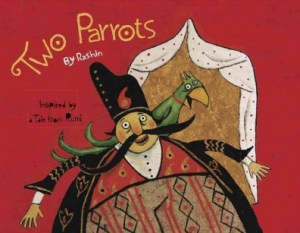
* Rashin. Two Parrots: Inspired by a Tale from Rumi. New York: North-South, 2014.
“A plucky parrot [purchased in India and] living in the home of a wealthy merchant [in Iran] appears to have everything. But, despite all this, the parrot is sad. The merchant will do anything to make his parrot happy! But will he be willing to set his beloved pet free?” – CIP. An outstanding picture to read aloud as a start to a philosophical discussion about freedom and material wealth.
* Ravishankar, Anushka. The Rumor. Toronto: Tundra Books, 2012, c2009.
A humorous tall tale about the dangers of gossip.
…
* Roy, Philip. Outlaw in India. Vancouver: Ronsdale Press, 2012.
“Alfred and his crew of Seaweed the seagull and Hollie the dog begin their exploration of India with a piece of bad luck when they surface behind a frigate and bring the wrath of the Indian navy down upon them.” – CIP. Part of a action-packed series recommended for readers 10 to 14 years old. [Adventure and adventurers; Submarines (Ships); Voyages and travels]
…
* Ruiz Zafon, Carlos. The Midnight Palace. New York : Little, Brown, 2011.
Ben has been raised in an orphanage in Calcutta, India. He thinks he is alone in the world until he discovers, on his sixteenth birthday, that he has a twin sister. He also discovers that a monstrous ghost from the past is trying to kill both of them. Set in the 1930s, this suspense-filled novel, translated from Spanish, will be enjoyed by readers eleven to sixteen years old. (India; Historical fiction; Demonology; Orphans; Twins; Secret societies; Friendship)
…
* Rumford, James. Nine Animals and the Well. Houghton Mifflin Company, 2003.
The rhythm in this hilarious tale about nine travelling animals bearing gifts for the raja-king makes it a great read-aloud for kindergarten to fourth grade students. And the page at the end that tells how we got the numbers 0 to 9 makes it even more interesting for readers of any age. The digits were invented in India about 1500 years ago and, from there, travelled to Arabia to North Africa and finally to Europe where they were called Arabic numbers.
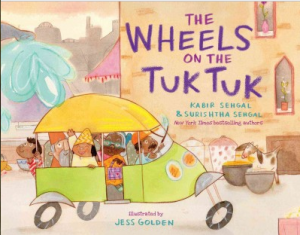
Sengal, Kabir & Surishtha Sengal. The Wheels on the Tuk Tuk. New York: Beach Lane Books, 2015.
Written to the rhythm of ‘The Wheels on the Bus’, this cheerful picture book will appeal to young children and nostalgic middle school readers.
Shea, Pegi Deitz. The Carpet Boy’s Gift. Tilbury House Press, 2003.
This picture book tells the story of Nadeem, a young boy who is inspired by a carpet boy named Iqbal to help other children gain their freedom by repaying the loans given to their parents by the factory owner. Includes lists of resources and teaching materials, bibliographies, websites and historical information. (Pakistan; Child labor; Runaways; Courage; AR 3.9)
* Sheth, Kashmira. Keeping Corner. Hyperion, 2007.
Married since she was nine years old, thirteen-year-old Leela’s childhood happiness ends when her husband dies. Only Mahatma Gandhi, with his social and political reforms, can bring any hope for the future. Set in India in the 1940s, this novel will appeal to readers in grades seven to nine. (India; Marriage; Young adult fiction; Culture conflict; Gandhi, Mahatma; Family life; Sex role; Historical fiction; Courage)
Sheth, Kashmira. Monsoon Afternoon. Peachtree, 2008.
Soft watercolour illustrations accompany this gentle story of a young boy and his loving grandfather spending time together on a rainy afternoon. This quiet picture book would be a lovely read-aloud for grades one to three. (India; Rain; Grandfathers; Family life)
Why do Sikhs remember 1897? Because of the extraordinary courage of some brave men. The Battle of Saragarhi, a graphic novel by Daljeet Singh Sidhu and Amarjit Virdi, tells the thrilling true tale of twenty-one riflemen who were stationed at a signalling post in northern India. They were attacked by Afghans and Pathans who greatly outnumbered them. What happened? On September 12th of that year, they boldly fought to the death to protect their post. Read this suspenseful story recommended for readers 11 years old and up. (Ramneek in grade 6)
Smith, Jeremy. Lily’s Garden of India. Columbus, Ohio : Gingham Dog Press, 2003.
Lily discovers a new path in one of her favorite places, her mother’s exotic garden, and the plants there teach her about the culture, festivals, food, and drink of their homeland, India.” – CIP. A guide to plants and festivals of India is included at the end of this cheerful picture book.
Staples, Suzanne Fisher. Shabanu. Dell Laurel-Leaf, 1989.
Eleven-year old Shabanu, daughter of a nomad in present-day Pakistan, is pledged to marry an older man and must decide whether to honour or defy her culture’s traditions. A 1990 Newbery Honor Book, the novel is on ERAC recommended novel list for grades 8 to 11. (Pakistan; Family life; Marriage; Sex role; Runaways; Muslims, Fathers and daughters; Young adult fiction; Newbery Medal; AR 5.9)
…
* Venkatraman, Padma. Climbing the Stairs. G.P. Putnam’s Sons, 2008.
Fifteen-year-old Vidya, her older brother and her parents move to the home of her paternal grandfather after her father is severely beaten during a non-violent demonstration in 1941 India. Instead of looking forward to someday attending college, she now has to face a life of servitude. This compelling young adult novel sensitively portrays different interpretations of the Hindu caste system, India’s struggle for independence and the complications of World War II. (India; WW 2; Historical fiction; Sex role; Hinduism; Family life; Brain damage; Prejudice; Love; Marriage; Jews; Courage; Guilt; Young adult fiction)
Climbing the Stairs by Padma Vekatramon (Putnam Juvenile May 1, 2008) is a brilliant story that takes place in India, in the early 1940’s during World War II. It will appeal to many girls who have grown up in India because Vidya, the main character, has to live in a house with, like, a million rules!
When tragedy strikes, Vidya and her brother, Kitta are forced to move into a traditional household with their grandpa and his extended family, a household where men live upstairs and women live downstairs. The women are meant to be married, not educated. Breaking the rules, Vidya finds her grandfather’s library on the second floor where she meets a guy named Raman who is exactly like her in many ways. He is smart and treats her as an equal, not like her periamma, who treats her like a servant. Soon Raman proposes to Vidya, just when he is about to go abroad. Will Vidya leave her studies to join Raman or will she stick with her family and suffer in that house? (Simran in grade eight)
* Whelan, Gloria. Homeless Bird. Harper, 2000.
Thirteen-year-old Kola’s family has decided it is time for her to be married. But what does she want to do? And how can she find a way to determine her own destiny in the face of tradition? (India; Marriage; Sex role; Courage)
* Whelan, Gloria. Small Amazing Acts of Courage. New York: Simon & Schuster Books for Young Readers, 2011.
“In 1919, independent-minded fifteen-year-old Rosalind lives in India with her English parents, and when they fear she has fallen in with some rebellious types who believe in Indian self-government, she is sent “home” to London, where she has never been before and where her older brother died, to stay with her two aunts.” – CIP. (Aunts; England; Grief; Historical fiction; India)
 Williams, Marcia. The Elephant’s Friend and Other Tales from Ancient India. Candlewick Press, 2012.
Williams, Marcia. The Elephant’s Friend and Other Tales from Ancient India. Candlewick Press, 2012.
Wilson, John. Where Soldiers Lie. Key Porter Books, 2006.
After his parents die, sixteen-year-old Jack is sent from Canada to live with relatives in Cawnpore, India. Filled with historical details about the 1857 war, this novel will appeal to readers in grades seven to nine. (India; Historical fiction; Adventure and adventurers; Soldiers; War; Romance; Courage)
Wolf, Gita. Gobble you up! Chennai, India: Tara Books, 2013.
A trickster tale of a greedy jackal. Based on a Rajasthani folktale. A great participatory read-aloud for 5 to 10 year olds.
Young, Beryl. Follow the Elephant. Ronsdale Press, 2010.
Thirteen-year-old Ben is carted along to India by his grandmother who is on a quest to find her long-lost childhood penpal. Grieving the recent death of his father and angry at everyone, Ben is determined to spend his time playing computer games. But the mystique of elephants arouses his curiosity. Rather flat characterization and cliched conversations mean this novel never really becomes more than a story on paper, but the sensory details and moodiness of the characters will appeal to less sophisticated readers in grades six to eight. (Death; Grief; Voyages and travels; India; Reincarnation; Elephants; Mystery and detective stories; Vancouver (B.C.); Friendship)
Biographies
Maslo, Lina. Free as a Bird: The Story of Malala. New York: Balzer & Bray an imprint of HarperCollinsPublishers, 2018. [Malala Yousafzai, an inspiring activist, is the youngest person to every win the Nobel Peace Prize. ]
McCarney, Rosemary. Every Day is Malala Day. Toronto: Second Story Press, 2014.
Winter, Jeanette. Malala, A Brave Girl from Pakistan; Iqbal, A Brave boy from Pakistan. New York: Beach Lane Books, 2014.
